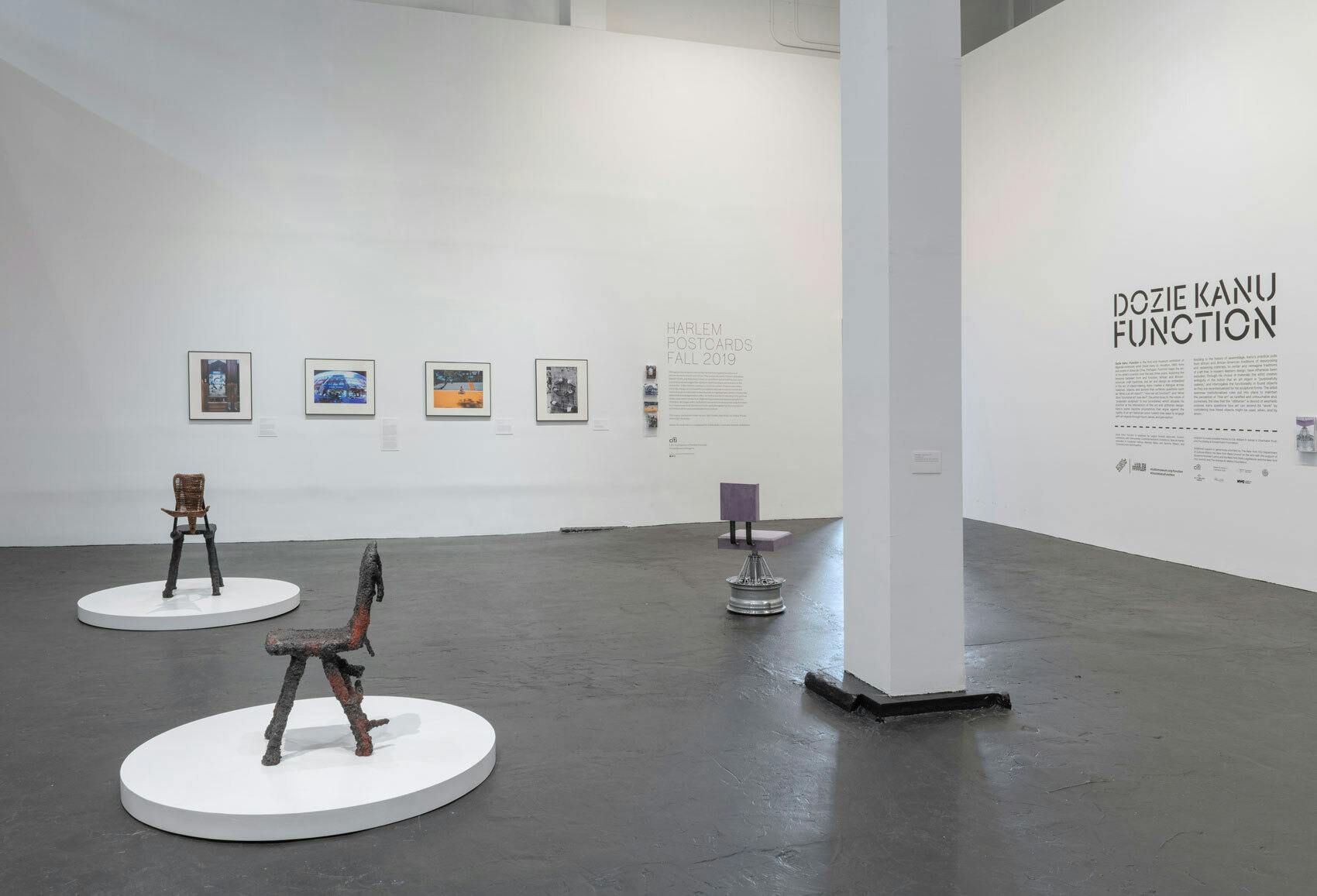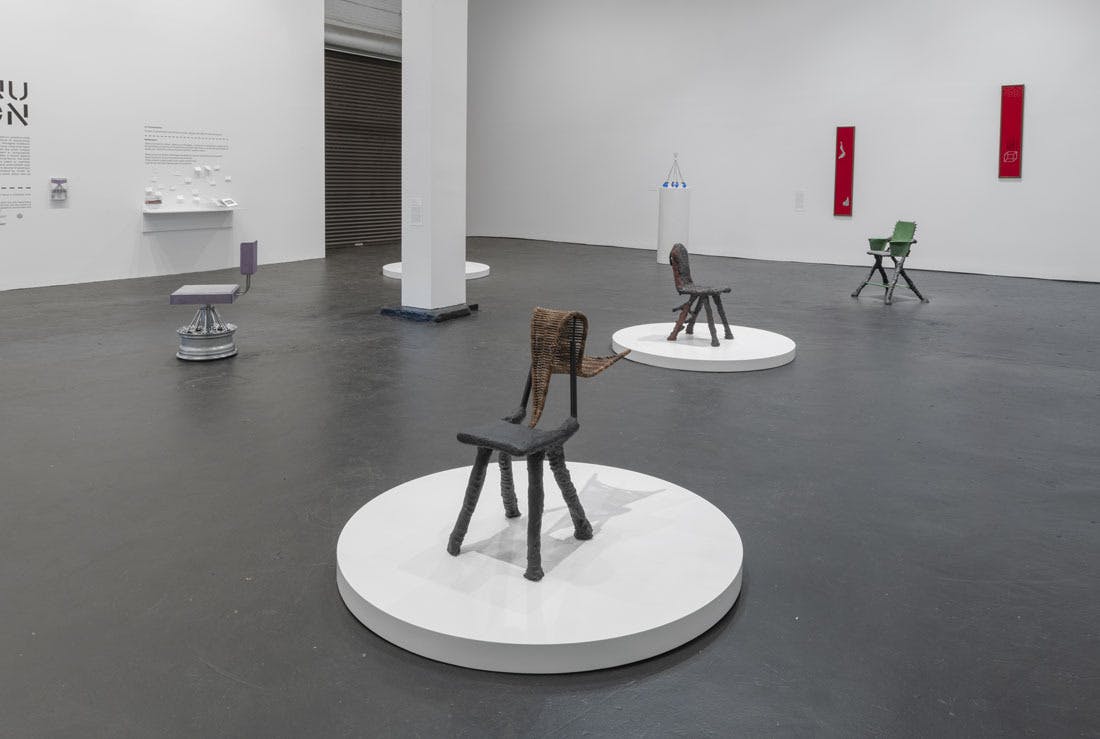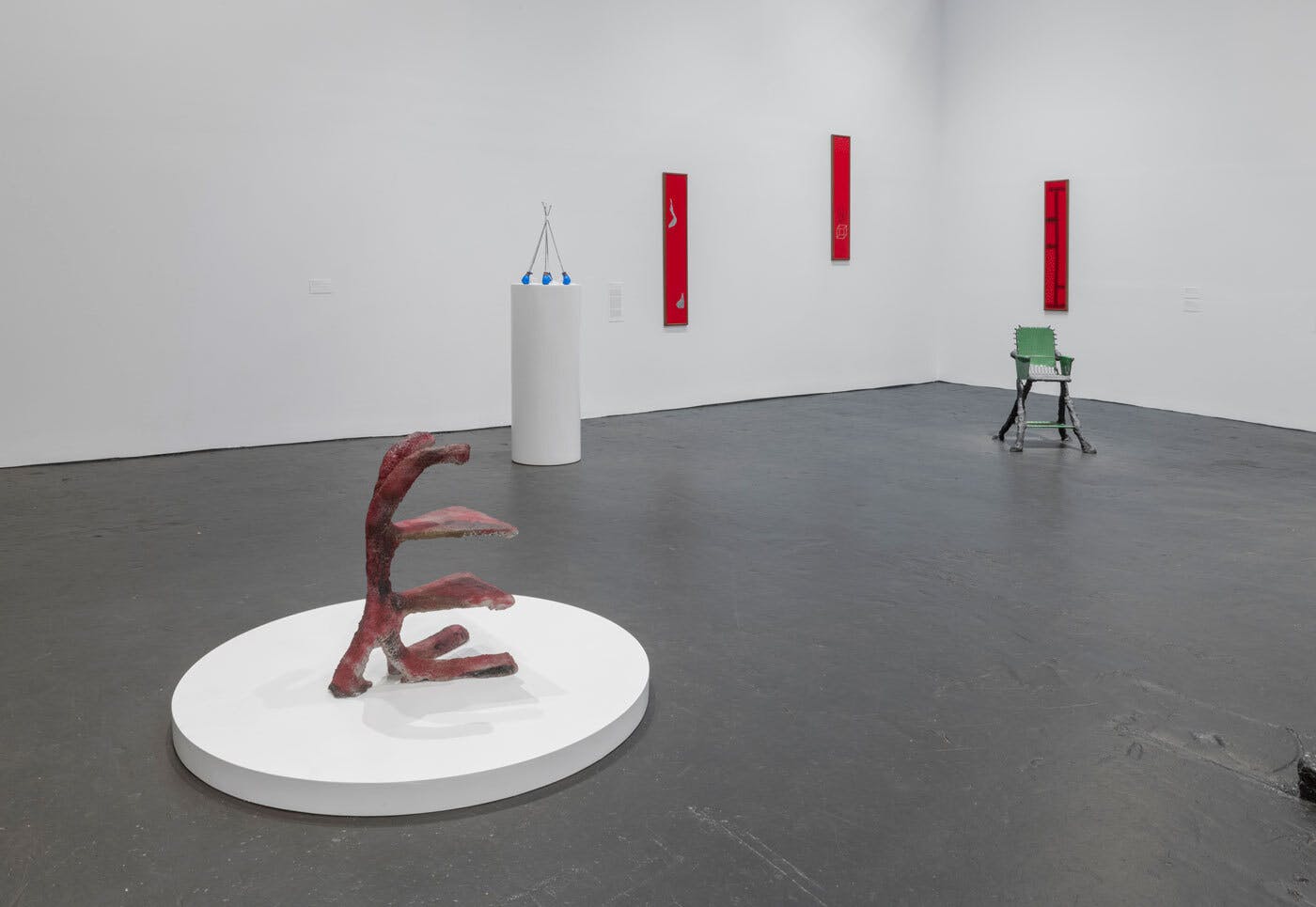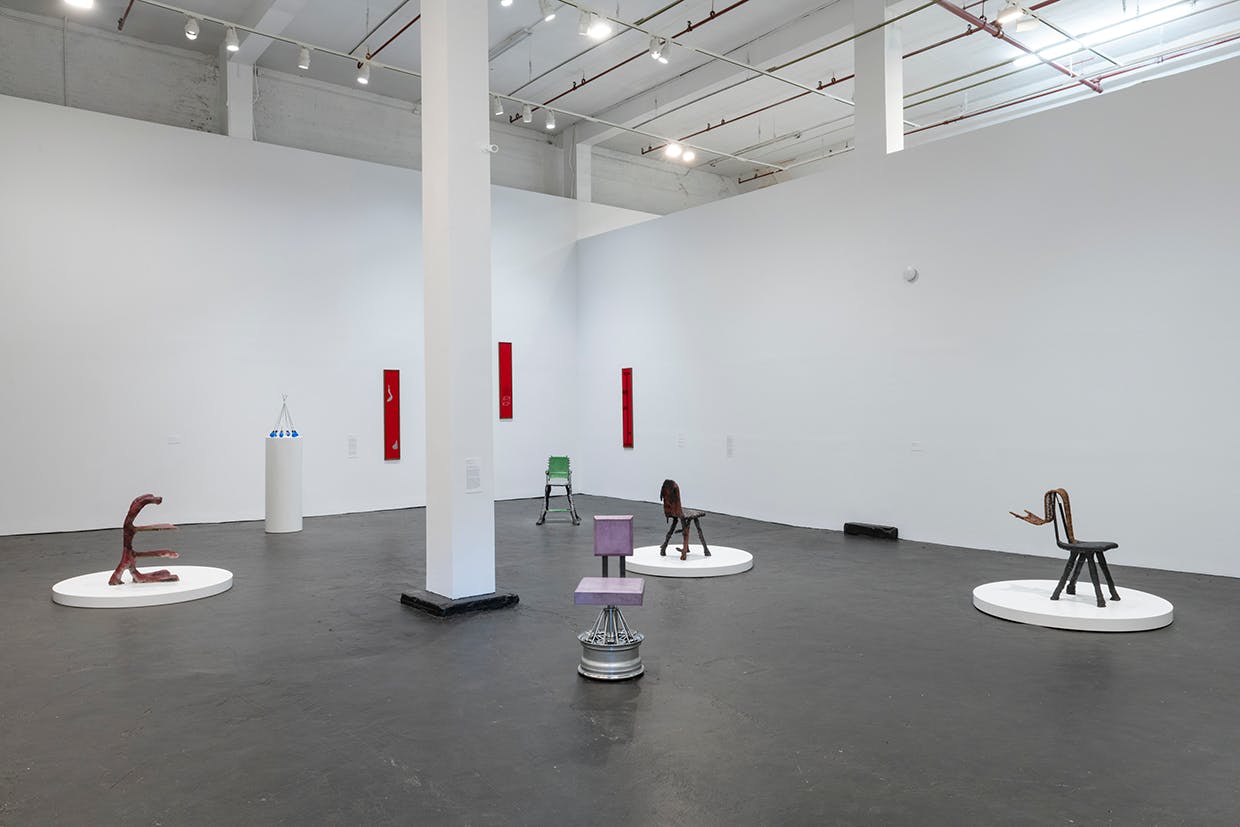Dozie Kanu: Function
November 15, 2019–March 29, 2020
Studio Museum 127, 429 W. 127th St.
Dozie Kanu: Function presents Nigerian-American artist Dozie Kanu in his first museum solo exhibition. This exhibition maps out the arc of Kanu’s practice over the last three years, exploring the tensions between form and function, African and African-American, and art and design as embedded in the act of object-making.
The dialogue across materials, objects, and actions here surfaces urgent questions: “What is an art object?,” “How can art function?,” and “What does ‘functional art’ look like?” Responsive to these queries, the artist looks to the notion of “pragmatic sculpture” as a means of blurring boundaries, situating his work at the intersection of fine art and utilitarian design. Kanu places these objects in dialogue within the rigidity of the traditional art historical canon. Ultimately, he argues for new ways to engage with art objects through touch, sense, and perception.
![Dozie Kanu
Chair [ ix ] (For Babies), 2019
Aluminum sheets, found baby chair, concrete,
36 x 24 ½ x 16 in.
Courtesy the artist](https://studiomuseum.imgix.net/images/DozieKanu_Function_Chair-forbabies_2023-09-14-134254_buvo.jpg?auto=format,compress&fit=max&w=4040)
Privileging African diasporic history as an instrument for creation, Dozie Kanu’s practice builds its own unique visual language. Raised in Texas by Nigerian immigrant parents, Kanu grew up negotiating the idea of a home divided between two places. It was not until December 2018 that he was first able to visit Nigeria, during which time he observed a new and abundant source of aesthetic inspiration.
Similar to the visual signals derived from his youth in Houston, while in Nigeria Kanu amassed a new set of aesthetic principles for an expanding series of work. At the core of this series, the artist mirrors the organic and tactile nature of the materials he encountered in Nigeria. This method of production engages Kanu’s evolving conception of his family’s home, and spotlights the qualities that existed in opposition to his preconceptions of African design prior to the visit. Further, Kanu continues his practice of repurposing objects by using pieces of aluminum and other found materials.
In Chair [ix] (For Babies), Kanu employs hand-sculpted concrete, which is pigmented to create a rich Black color. The shape and build of the object uses a child’s high chair as its foundation, as denoted by the title of the work. Kanu also uses green aluminum sheets stripped from a Nigerian trunk to create a strong woven back to the chair, the artist’s gesture to African craft. Such elements are borrowed from a long tradition of hair braiding and weaving.
At the forefront of his practice, Kanu produces objects disguised by their assumed utility. When embedding physical and visual content from his past, he also asserts an underlying ethos of following material intuition. Kanu relocated his practice from New York to Azoia de Cima, Portugal; the artist’s studio there is near a marble quarry, in a warehouse conveniently situated alongside a material often found in rarified object design. Pieces such as the one on display point not only to his unique understanding of conservation and rebirth, but also to his acknowledgement of art and design’s historical roots in Black artisanship. In the artist’s words, “American design doesn’t always include Black people.” With this in mind, the works here strive to make space for a uniquely Black vernacular for designing objects that draw from material recognizable to a diasporic lived experience.
Kanu urges viewers to question whether looking at an object purely for its practical sensibility undermines its value as an expression of artistry. In this way his pieces may be more justly treated as contemporary artifacts. Their functions lie as much in their capacity for storytelling as in their practical use. By establishing longevity for these objects—creating in them a second life—Kanu finds a way to produce work that champions an intersection between history and material.
—Sami Hopkins

Unlike Dozie Kanu’s chairs, which are derived from practical items used in everyday life, the artist’s wall works are made from Catholic panels found in antique shops in Portugal. Created with staples, red velvet, and a repurposed wooden panel, Wouldn’t Believe achieves a painterly composition through the dense layering of metal staples within the frame. Here, Kanu plays with painting as a concept, and uses it to deconstruct religious symbolism and trouble the boundary between “art” and “design.”
Covering the religious panel with new red velvet, the artist weaves together found and unrelated objects into an assemblage, which creates an abstract composition that rests between collage and painting. Kanu then creates a tactile artwork through repetition, performative in his stapling of metal into the surface of the image. For Kanu, assemblage is a way of processing material and cultural references, and he repurposes simple materials to infuse them with new meaning. The process of putting staples (an everyday material) into the wood leaves no traditional trace of painted gesture, but still evidences the artist’s hand. Each fragment is a small metallic accumulation of line and shape that moves the work further into the realm of assemblage as both a metaphor and a stylistic exercise.
Embedded in Kanu’s artistic process is what art historian Kellie Jones calls “the concept of transformation, the alchemy of taking a thing discarded and changing it into a thing of (re)use.” The artist embraces painting without paint, distilling the process into its most essential parts (color, composition, surface, and shape). Kanu invests this object with intention and attention, and transforms it to reflect a fluidity in both his immediate material environment and the cultures around him.
—Makayla Bailey
![Dozie Kanu
Chair [iii], 2018.
Poured concrete, steel, rims,
37 x 19 x 16 1/2 in.
Courtesy the artist](https://studiomuseum.imgix.net/images/DozieKanu-Function-Chairiii.jpg?auto=format,compress&fit=max&w=4040)
“Slow Loud And Bangin,” all in my trunk
Trunk full of funk, I ain't never been a punk
—Z-Ro, “Mo City Don Freestyle,” 2005
A shiny candy paint coating, a popped trunk, and an explosive sound system are key features of a “slab.” Known throughout Dozie Kanu’s hometown of Houston, a slab is typically a customized Cadillac, Lincoln, or Oldsmobile with Texan Wire Wheels and protruding conical rims called “swangas” or “elbows.” Slabs emerged in Houston’s African-American communities during the mid-1980s and early 1990s as a form of artistic expression and, in some cases, a way to flaunt wealth and success.
From the back of his parents’ car after school Kanu routinely saw slabs on the streets. His memory of their parades, with sonic booms, neon signage, and spotless rims, is indelible. Chair [iii] is composed of a concrete seat and back of a chair supported by a steel “elbow.” The purple color references “lean,” a drink composed of prescription cough syrups containing codeine or promethazine, soda, and flavored candy. The drink is often referenced in rap songs, some by Houston artists, and has a sedating effect that can slow the user’s perception. Through these choices the artist offers new ways to consider the “speed” of an object and the prevalence of “fast design” in an era of mass production in contemporary culture.
—Jasmine Wilson
Dozie Kanu: Function is organized by Legacy Russell, Associate Curator, Exhibitions, with Yelena Keller, Curatorial Assistant, Exhibitions. Special thanks to Curatorial Fellows Makayla Bailey and Jasmine Wilson, and Curatorial Intern Sami Hopkins.
Dozie Kanu: Function
November 15, 2019–March 29, 2020
Studio Museum 127, 429 W. 127th St.
Dozie Kanu: Function presents Nigerian-American artist Dozie Kanu in his first museum solo exhibition. This exhibition maps out the arc of Kanu’s practice over the last three years, exploring the tensions between form and function, African and African-American, and art and design as embedded in the act of object-making.
The dialogue across materials, objects, and actions here surfaces urgent questions: “What is an art object?,” “How can art function?,” and “What does ‘functional art’ look like?” Responsive to these queries, the artist looks to the notion of “pragmatic sculpture” as a means of blurring boundaries, situating his work at the intersection of fine art and utilitarian design. Kanu places these objects in dialogue within the rigidity of the traditional art historical canon. Ultimately, he argues for new ways to engage with art objects through touch, sense, and perception.
![Dozie Kanu
Chair [ ix ] (For Babies), 2019
Aluminum sheets, found baby chair, concrete,
36 x 24 ½ x 16 in.
Courtesy the artist](https://studiomuseum.imgix.net/images/DozieKanu_Function_Chair-forbabies_2023-09-14-134254_buvo.jpg?auto=format,compress&fit=max&w=4040)
Privileging African diasporic history as an instrument for creation, Dozie Kanu’s practice builds its own unique visual language. Raised in Texas by Nigerian immigrant parents, Kanu grew up negotiating the idea of a home divided between two places. It was not until December 2018 that he was first able to visit Nigeria, during which time he observed a new and abundant source of aesthetic inspiration.
Similar to the visual signals derived from his youth in Houston, while in Nigeria Kanu amassed a new set of aesthetic principles for an expanding series of work. At the core of this series, the artist mirrors the organic and tactile nature of the materials he encountered in Nigeria. This method of production engages Kanu’s evolving conception of his family’s home, and spotlights the qualities that existed in opposition to his preconceptions of African design prior to the visit. Further, Kanu continues his practice of repurposing objects by using pieces of aluminum and other found materials.
In Chair [ix] (For Babies), Kanu employs hand-sculpted concrete, which is pigmented to create a rich Black color. The shape and build of the object uses a child’s high chair as its foundation, as denoted by the title of the work. Kanu also uses green aluminum sheets stripped from a Nigerian trunk to create a strong woven back to the chair, the artist’s gesture to African craft. Such elements are borrowed from a long tradition of hair braiding and weaving.
At the forefront of his practice, Kanu produces objects disguised by their assumed utility. When embedding physical and visual content from his past, he also asserts an underlying ethos of following material intuition. Kanu relocated his practice from New York to Azoia de Cima, Portugal; the artist’s studio there is near a marble quarry, in a warehouse conveniently situated alongside a material often found in rarified object design. Pieces such as the one on display point not only to his unique understanding of conservation and rebirth, but also to his acknowledgement of art and design’s historical roots in Black artisanship. In the artist’s words, “American design doesn’t always include Black people.” With this in mind, the works here strive to make space for a uniquely Black vernacular for designing objects that draw from material recognizable to a diasporic lived experience.
Kanu urges viewers to question whether looking at an object purely for its practical sensibility undermines its value as an expression of artistry. In this way his pieces may be more justly treated as contemporary artifacts. Their functions lie as much in their capacity for storytelling as in their practical use. By establishing longevity for these objects—creating in them a second life—Kanu finds a way to produce work that champions an intersection between history and material.
—Sami Hopkins

Unlike Dozie Kanu’s chairs, which are derived from practical items used in everyday life, the artist’s wall works are made from Catholic panels found in antique shops in Portugal. Created with staples, red velvet, and a repurposed wooden panel, Wouldn’t Believe achieves a painterly composition through the dense layering of metal staples within the frame. Here, Kanu plays with painting as a concept, and uses it to deconstruct religious symbolism and trouble the boundary between “art” and “design.”
Covering the religious panel with new red velvet, the artist weaves together found and unrelated objects into an assemblage, which creates an abstract composition that rests between collage and painting. Kanu then creates a tactile artwork through repetition, performative in his stapling of metal into the surface of the image. For Kanu, assemblage is a way of processing material and cultural references, and he repurposes simple materials to infuse them with new meaning. The process of putting staples (an everyday material) into the wood leaves no traditional trace of painted gesture, but still evidences the artist’s hand. Each fragment is a small metallic accumulation of line and shape that moves the work further into the realm of assemblage as both a metaphor and a stylistic exercise.
Embedded in Kanu’s artistic process is what art historian Kellie Jones calls “the concept of transformation, the alchemy of taking a thing discarded and changing it into a thing of (re)use.” The artist embraces painting without paint, distilling the process into its most essential parts (color, composition, surface, and shape). Kanu invests this object with intention and attention, and transforms it to reflect a fluidity in both his immediate material environment and the cultures around him.
—Makayla Bailey
![Dozie Kanu
Chair [iii], 2018.
Poured concrete, steel, rims,
37 x 19 x 16 1/2 in.
Courtesy the artist](https://studiomuseum.imgix.net/images/DozieKanu-Function-Chairiii.jpg?auto=format,compress&fit=max&w=4040)
“Slow Loud And Bangin,” all in my trunk
Trunk full of funk, I ain't never been a punk
—Z-Ro, “Mo City Don Freestyle,” 2005
A shiny candy paint coating, a popped trunk, and an explosive sound system are key features of a “slab.” Known throughout Dozie Kanu’s hometown of Houston, a slab is typically a customized Cadillac, Lincoln, or Oldsmobile with Texan Wire Wheels and protruding conical rims called “swangas” or “elbows.” Slabs emerged in Houston’s African-American communities during the mid-1980s and early 1990s as a form of artistic expression and, in some cases, a way to flaunt wealth and success.
From the back of his parents’ car after school Kanu routinely saw slabs on the streets. His memory of their parades, with sonic booms, neon signage, and spotless rims, is indelible. Chair [iii] is composed of a concrete seat and back of a chair supported by a steel “elbow.” The purple color references “lean,” a drink composed of prescription cough syrups containing codeine or promethazine, soda, and flavored candy. The drink is often referenced in rap songs, some by Houston artists, and has a sedating effect that can slow the user’s perception. Through these choices the artist offers new ways to consider the “speed” of an object and the prevalence of “fast design” in an era of mass production in contemporary culture.
—Jasmine Wilson
Dozie Kanu: Function is organized by Legacy Russell, Associate Curator, Exhibitions, with Yelena Keller, Curatorial Assistant, Exhibitions. Special thanks to Curatorial Fellows Makayla Bailey and Jasmine Wilson, and Curatorial Intern Sami Hopkins.
Studio Museum 127, 429 W. 127th St.



